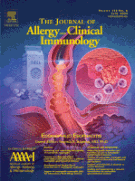Effective prevention and therapy of experimental allergic asthma using a GATA-3–specific DNAzyme - 15/08/11
 , Holger Garn, PhD a, c
, Holger Garn, PhD a, cAbstract |
Background |
Allergic bronchial asthma is a chronic inflammatory disease of the airways. The transcription factor GATA-3 was shown to play an important role in TH2 cell activation, but also in the regulation of other cell types involved in bronchial asthma including mast cells, eosinophils, and epithelial cells. DNAzymes represent a new class of antisense molecules that combines the specificity of DNA base pairing with an inherent RNA-cleaving enzymatic activity.
Objective |
To develop a GATA-3 mRNA-specific DNAzyme and analyze its allergy-preventing activity in murine models of experimental allergic asthma.
Methods |
The most active DNAzyme (termed gd21) was selected by in vitro cleavage assays. Allergic airway inflammation was assessed by inflammatory cell and cytokine analysis within bronchoalveolar lavage. Lung histology, including goblet cell hyperplasia and lung function, was analyzed using head-out body-plethysmography.
Results |
Intranasal administration of gd21 prevented airway inflammation and mucus production and inhibited development of airway hyperresponsiveness to methacholine in models of acute allergic airway inflammation. Similar effects were also detected in a model of chronic experimental asthma. Interestingly, gd21 was at least as effective as other antisense molecules, and off-target effects were not detected. Further experiments indicated that pulmonary surfactant may facilitate the cellular uptake of gd21 by acting as an endogenous transfectant.
Conclusion |
These results indicate that topical application of the GATA-3–specific DNAzyme is a promising novel approach for the treatment of allergic bronchial asthma.
Le texte complet de cet article est disponible en PDF.Key words : Allergic asthma, GATA-3, DNAzymes, TH2 cells, antisense DNA, small interference RNA
Abbreviations used : AHR, asDNA, BAL, BDNF, FACS, HE, MCh, MCP, NGF, PAS, siRNA, TLR
Plan
| Supported by Deutsche Forschungsgemeinschaft Sonderforschungsbereich/Transregio 22 and Sterna Biologicals GmbH and Co KG. |
|
| Disclosure of potential conflict of interest: M. Wegmann, H. Renz, and H. Garn are cofounders of Sterna Biologicals. The rest of the authors have declared that they have no conflict of interest. |
Vol 121 - N° 4
P. 910 - avril 2008 Retour au numéroBienvenue sur EM-consulte, la référence des professionnels de santé.
L’accès au texte intégral de cet article nécessite un abonnement.
Déjà abonné à cette revue ?

